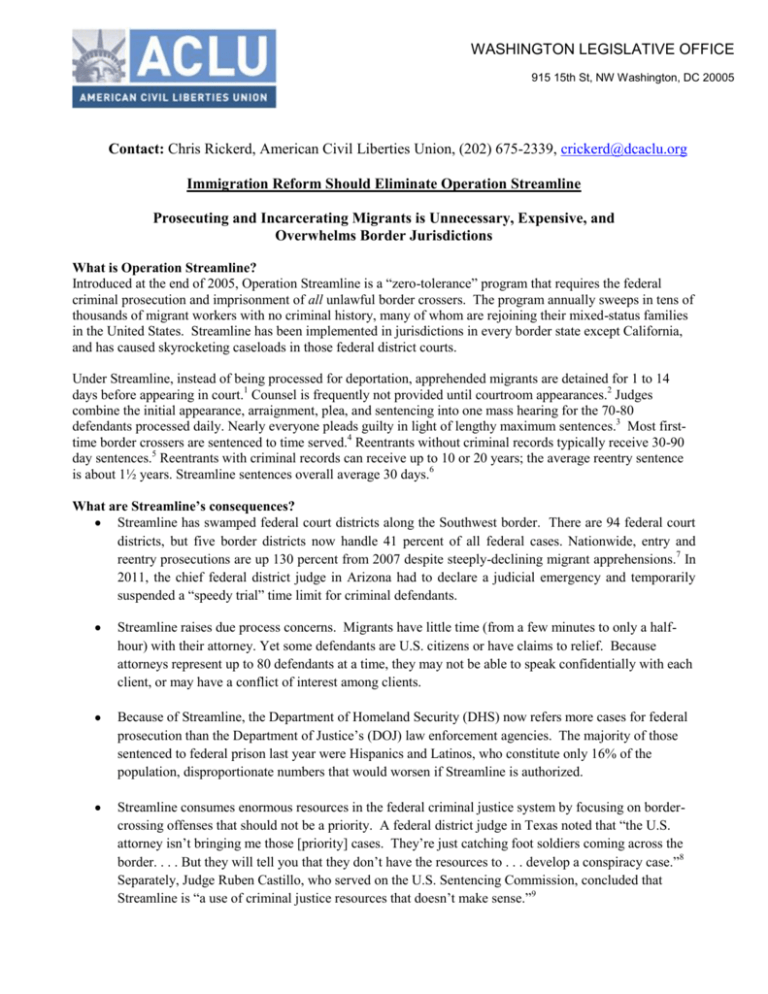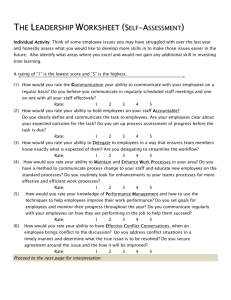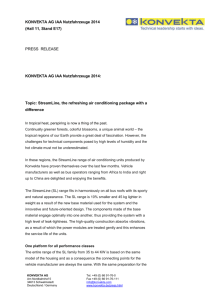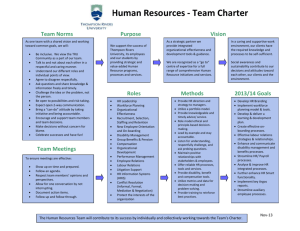Immigration Reform Should Eliminate Operation Streamline
advertisement

WASHINGTON LEGISLATIVE OFFICE 915 15th St, NW Washington, DC 20005 Contact: Chris Rickerd, American Civil Liberties Union, (202) 675-2339, crickerd@dcaclu.org Immigration Reform Should Eliminate Operation Streamline Prosecuting and Incarcerating Migrants is Unnecessary, Expensive, and Overwhelms Border Jurisdictions What is Operation Streamline? Introduced at the end of 2005, Operation Streamline is a “zero-tolerance” program that requires the federal criminal prosecution and imprisonment of all unlawful border crossers. The program annually sweeps in tens of thousands of migrant workers with no criminal history, many of whom are rejoining their mixed-status families in the United States. Streamline has been implemented in jurisdictions in every border state except California, and has caused skyrocketing caseloads in those federal district courts. Under Streamline, instead of being processed for deportation, apprehended migrants are detained for 1 to 14 days before appearing in court.1 Counsel is frequently not provided until courtroom appearances.2 Judges combine the initial appearance, arraignment, plea, and sentencing into one mass hearing for the 70-80 defendants processed daily. Nearly everyone pleads guilty in light of lengthy maximum sentences.3 Most firsttime border crossers are sentenced to time served.4 Reentrants without criminal records typically receive 30-90 day sentences.5 Reentrants with criminal records can receive up to 10 or 20 years; the average reentry sentence is about 1½ years. Streamline sentences overall average 30 days.6 What are Streamline’s consequences? Streamline has swamped federal court districts along the Southwest border. There are 94 federal court districts, but five border districts now handle 41 percent of all federal cases. Nationwide, entry and reentry prosecutions are up 130 percent from 2007 despite steeply-declining migrant apprehensions.7 In 2011, the chief federal district judge in Arizona had to declare a judicial emergency and temporarily suspended a “speedy trial” time limit for criminal defendants. Streamline raises due process concerns. Migrants have little time (from a few minutes to only a halfhour) with their attorney. Yet some defendants are U.S. citizens or have claims to relief. Because attorneys represent up to 80 defendants at a time, they may not be able to speak confidentially with each client, or may have a conflict of interest among clients. Because of Streamline, the Department of Homeland Security (DHS) now refers more cases for federal prosecution than the Department of Justice’s (DOJ) law enforcement agencies. The majority of those sentenced to federal prison last year were Hispanics and Latinos, who constitute only 16% of the population, disproportionate numbers that would worsen if Streamline is authorized. Streamline consumes enormous resources in the federal criminal justice system by focusing on bordercrossing offenses that should not be a priority. A federal district judge in Texas noted that “the U.S. attorney isn’t bringing me those [priority] cases. They’re just catching foot soldiers coming across the border. . . . But they will tell you that they don’t have the resources to . . . develop a conspiracy case.”8 Separately, Judge Ruben Castillo, who served on the U.S. Sentencing Commission, concluded that Streamline is “a use of criminal justice resources that doesn’t make sense.”9 What if every immigrant apprehended in the Tucson sector were prosecuted through Streamline? It would be very expensive. Tucson currently prosecutes about 1 out of every 10 border apprehensions through Streamline; if every migrant apprehended in Tucson in 2011 had received the average Streamline sentence of 30 days,10 the costs of incarceration alone would have been an additional $301 million.11 That doesn’t include court costs – judges, prosecutors, defense attorneys, and even new buildings – to handle more than 100,000 additional immigration cases. The federal prison system is already at 139% of operational capacity, so any added immigration prisoners would need to be housed in new facilities, which would likely be privately operated. The federal government currently is obligated to private companies for $5.1 billion, through 13 contracts of varying lengths, to house more than 23,000 immigrants prosecuted federally.12 If every migrant apprehended in the Tucson sector were to spend the average 30 days in prison, there would need to be about 8,000 more beds procured for this group alone.13 Why should we doubt Streamline’s efficacy? There is no proof that Streamline is having a deterrent impact. Over the last decade, in a trend beginning well before Streamline, migrant apprehensions by the Border Patrol have declined more than 72 percent (2000-10). They are lower than at any time since the 1970s. Net migration from Mexico is now zero or slightly negative (more people leaving than coming), and experts agree that this is due to a variety of factors.14 Streamline’s contribution to the decline is unproven: it should not be expanded on speculation. Apprehensions fell more in Customs and Border Protection’s (CBP) non-Streamline sectors than in Streamline sectors. Between FY2008 and FY2011, apprehensions fell by a greater percentage in San Diego (which is not part of Streamline) than in any Streamline sector.15 The Yuma and El Paso sectors prosecute every apprehended migrant through Streamline, but have rates of recidivism almost identical to nearby sectors (respectively, Tucson and Del Rio/Laredo) that prosecute a fraction of apprehended migrants through Streamline.16 What’s gone wrong in the Bureau of Prisons’ private Criminal Alien Requirement (CAR) facilities, which incarcerate non-violent federal immigrant prisoners? In 2009 at the Reeves County Detention Center – a CAR prison in Pecos, West Texas – immigrant prisoners organized an uprising after a man with epilepsy died from a seizure. An ACLU lawsuit alleges that medical staff failed to provide him anti-convulsant medication 90 times. His gums began to bleed and he suffered frequent seizures, but he was placed in segregation rather than helped. The lawsuit alleges that there was not even a nurse available on weekends.17 In 2011, PBS’s Frontline detailed sexual abuse of Immigration and Customs Enforcement (ICE) detainees at the Willacy Detention Center in Raymondville, Texas.18 The investigation revealed that “Willacy Detention Center garnered more complaints of sexual abuse than any other facility.” Despite ICE’s termination of its Willacy contract with private prison company MTC, BOP entered into a 10year, $532 million contract for CAR beds provided by MTC in Willacy County.19 300 inmates rioted in May 2012 to call attention to substandard prison conditions and inadequate medical care in Natchez, Mississippi. One guard was killed and 20 people were injured.20 1 Joanna Lydgate, “Assembly Line Justice: A Review of Operation Streamline”, June 2010, p. 499, http://www.californialawreview.org/assets/pdfs/98-2/Lydgate_FINAL.pdf. Written Statement of Heather Williams, House Judiciary Subcommittee on Commercial and Administrative Law, Oversight Hearing on the Executive Office of U.S. Attorneys, June 2008, Appendix 1-1, http://judiciary.house.gov/hearings/pdf/Williams080625.pdf 2 Williams supra note 1 3 Lydgate supra note 1, p. 484 4 Lydgate supra note 1, p. 508; Williams supra note 1, p. 6; Cañas, Daly, and Orrenius, “Did Operation Streamline Slow Illegal Immigration?”, November 2011, p. 6, http://www.nobe-ref.org/pdf/Nobe%20Symposium%20121/Canas_et_al_Dec_1_11.pdf; Gambino, “The Busiest Border Patrol Sector”, AZNews21 (2010), http://asu.news21.com/2010/the-busiest-border-patrol-sector/ 5 U.S. Customs and Border Protection, Performance and Accountability Report: Fiscal Year 2009, available at http://www.cbp.gov/linkhandler/cgov/newsroom/publications/admin/perform_rpt_2009.ctt/perform_rpt_2009.pdf at 12-13. Lydgate supra note 1, pp. 508-14; Williams supra note 1, p. 6 6 See “Program Prosecutes Illegal Immigrants Before Deporting Them”, Lauren Gambino, AZNews21 (2010), http://asu.news21.com/2010/prosecuting-illegal-immigrants/; Brady McCombs, Banderas News, April 2008, http://www.banderasnews.com/0804/nw-uszeroplan.htm; Lydgate supra note 1, p. 528; Williams supra note 1, pp. 4, 8, 19, testifying that CBP recommends 30 days as a sentence for Streamline defendants. 7 “Immigration Prosecutions for June 2012,” TRAC Reports (Aug. 27, 2012), available at http://trac.syr.edu/tracreports/bulletins/immigration/monthlyjun12/fil/ 8 Solomon Moore, Push on Immigration Crimes Is Said to Shift Focus, New York Times, (Jan. 11, 2009). 9 Forrest Wilder, “The Lawsuit West of the Pecos.” Texas Observer (Dec. 8, 2010), available at http://www.texasobserver.org/forrestforthetrees/the-lawsuit-west-of-the-pecos 10 See note 6 supra. 11 In 2011, 123,285 persons we apprehended in the Tucson sector; see Customs and Border Protection Statistics, “Total Illegal Alien Apprehensions by Fiscal Year” (2012), http://www.cbp.gov/linkhandler/cgov/border_security/border_patrol/usbp_statistics/usbp_fy12_stats/nationwide_appr_2000_ 2012.ctt/nationwide_appr_2000_2012.pdf. The per-diem U.S. Marshals cost in FY2011 of the private facilities which hold most immigration prisoners in was $90.62; USMS, “Average Per Diem Rate Paid, by Type of Facility, Fiscal Year 19942011”, http://www.justice.gov/ofdt/perdiem-paid.htm. The average sentence is 30 days; see note 6 supra. The incarceration costs for the entire Tucson apprehension cohort in 2011 would have been $335 million; if the current apprehension rate is about 10 percent, then the added cost of expanding Streamline in Tucson would be about $301 million per year at current levels of immigration in that sector. 12 “Immigrants Prove Big Business for Prison Companies,” Associated Press/USA Today, August 2, 2012, http://news.yahoo.com/immigrants-prove-big-business-prison-companies-084353195.html 13 123,285 annual apprehensions means that the Border Patrol is arresting about 337 immigrants in the Tucson sector every day. 99% of Streamline defendants plead guilty, so assume that each of those 337 enters prison, and that no prison bed can be reused until an already-incarcerated immigrant is released after the average 30-day sentence. 337*30 equals 10,110. The current bed requirement is 70*30 (currently the Tucson sector prosecutes 70 Streamline cases daily), or 2,100. The bed requirement of expansion is the difference, 8,010. 14 Pew Research Hispanic Center, Net Migration from Mexico Falls to Zero—and Perhaps Less, May 2012, http://www.pewhispanic.org/2012/04/23/net-migration-from-mexico-falls-to-zero-and-perhaps-less/ 15 Over that four-year period, apprehensions in San Diego fell by about 76%, outpacing Tucson (62%), El Paso (66%), and all other Streamline districts. United States Border Patrol, “Total Illegal Alien Apprehensions By Fiscal Year”, http://www.cbp.gov/linkhandler/cgov/border_security/border_patrol/usbp_statistics/usbp_fy11_stats/60_10_app_stats.ctt/60_ 11_app_stats.pdf 16 GAO, “Key Elements of New Strategic Plan Not Yet in Place to Inform Border Security Status and Resource Needs”, December 2012, https://media.azpm.org/master/document/2013/1/9/pdf/gaoborderreport.pdf 17 Wilder, “Lawsuit,” supra note 9. 18 Catherine Rentz, “How Much Sexual Abuse Gets ‘Lost in Detention’?” (Oct. 19, 2011), available at http://www.pbs.org/wgbh/pages/frontline/race-multicultural/lost-in-detention/how-much-sexual-abuse-gets-lost-in-detention/ 19 Jasen Asay, “Private prison company lands federal contract.” (Ogden, UT) Standard-Examiner (June 8, 2011), available at http://www.standard.net/topics/economy/2011/06/07/private-prison-company-lands-federal-contract 20 Associated Press, “FBI reports Mexican group 'Paisas' started prison riot in Adams County.” (Aug. 13, 2012) (“FBI spokeswoman Deborah Madden said Paisas are a loosely affiliated group within the prison, without ties to organized gangs.”), available at http://blog.gulflive.com/mississippi-press-news/2012/08/fbi_reports_mexican_group_pais.html








